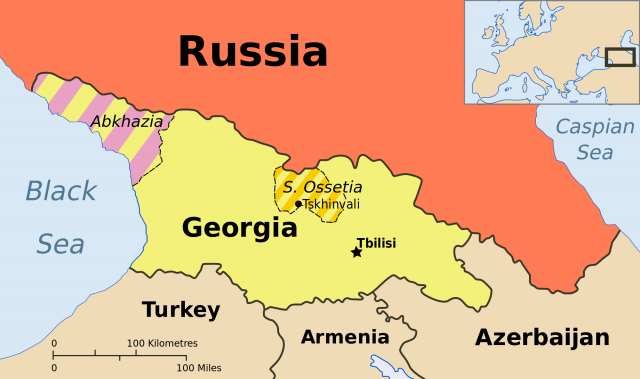Georgia
Area 43,310 square mi (69,700 square km)
Population 4.504 million 2014
Capital T'bilisi
Highest Point 17,064 ft (5,201 m)
Lowest Point 0 m
GDP $16.53 billion 2014
Primary Natural Resources forests, hydropower, manganese, iron ore, copper.
LOCATED IN THE REGION known as the Caucasus or Caucasia, Georgia is a small country, about the size of WEST VIRGINIA. To the north and northeast, Georgia borders the Russian republics of CHECHNYA, Ingushetia, and North Ossetia. Neighbors to the south are ARMENIA, AZERBAIJAN, and TURKEY. The shoreline of the BLACK SEA constitutes Georgia's entire western border. Georgia was absorbed into the Russian empire in the 19th century. Independent for three years (1918 to 1921) following the Russian Revolution, it was incorporated into the Soviet Union and became independent again in 1991.
The Georgian nation represents a fusion of local inhabitants with tribes infiltrating from Asia Minor in remote antiquity. There has also been an admixture of Greek, Scythian, Iranian, and Armenian elements. Ethnic groups in Georgia include Georgian (70.1 percent), Armenian (8.1 percent), Russian (6.3 percent), Azeri (5.7 percent), Ossetian (3 percent), Abkhaz (1.8 percent), and others (5 percent).

THREE REGIONS
Georgia falls into three main structural regions, which originated in the vast earth movements of the Alpine folding period. In the north is the Greater Caucasus range, in the center a tectonic depression or trough, and in the south the mountains of Transcaucasia. All the southern flank of the Greater Caucasus range, usually regarded as the boundary of Europe and Asia, lies in Georgia, as far east as Mount Diklos-Mta. Although the highest peak, ELBRUS, lies just over the boundary of the republic, many high peaks are on the crest line: Shkhara, 17,063 ft (5,201 m); Dzhangitau, 16,565 ft (5,049 m); Kazbek, 16,558 ft (5,047 m); and Ushba, 15,453 ft (4,710 m). Many of these peaks have extensive glaciers. Toward the west, approaching the narrow coastal strip along the Black Sea, the range becomes lower. South of the main range is a series of lower ranges, usually roughly parallel to it and separated from it and from each other by deep valleys and gorges. From west to east the chief of these ranges are Gagrinski, Bzybski, Abkhaz, Kodorski, Svanetski, Metrelski, Lechkhumski, and Rachinski. Farther east, the Suramski Kartalinski and Nakhetinski ranges are perpendicular to the greater Caucasus.
The rivers, which mostly rise in the ice field, are many and fast-flowing, the largest being the Bzyb, Kodori, Inguri, Tskhenis-Tskali, and Rioni, which flow to the Black Sea and the Kura tributaries—Aragvi, Iori and Alazani—flowing to the Caspian. In the extreme northwest is the picturesque Lake Ritsa.
The tectonic trough is divided in two by a saddle formed by the Suramski range. To the west is the wedge-shaped lowland of Kolkhinda, the legendry land of the Golden Fleece. Rioni and other mountain rivers bring an enormous volume of water and silt, which have formed a widespread swamp. East of the Suramski saddle, the trough continues as a series of high, level plains, notably those of Gori and Rustavi, drained to the east by the Kura and its tributaries. The third region, in the south, consists of ranges and plateaus, often called the Lesser Caucasus.
Georgia's climate is affected by subtropical influences from the west and Mediterranean influences from the east. The Greater Caucasus range moderates local climate by serving as a barrier against cold air from the north. Warm, moist air from the Black Sea moves easily into the coastal lowlands from the west. Climatic zones are determined by distance from the Black Sea and by altitude.
Georgia's history is in some respects similar to Armenia's: In both cases small nations have successfully maintained their ancient cultures against successive invaders and regional overlords. Georgia's own Orthodox Christian Church played an important role in preserving the nation's identity, culture, and traditions. The Georgian group of languages is unique and does not belong to any of the major language families. From the 18th century to the present day, Georgia has from time to time turned to RUSSIA for protection and help: Russia's response over the years has varied according to its interests. Since independence, the people of Georgia have endured periods of civil war related to the independence aspirations of the breakaway regions of Abkhazia and South Ossetia. Although diplomatic efforts have brought relative stability in recent years, tensions over both regions persist.
Georgia's main economic activities include the cultivation of agricultural products such as citrus fruits, tea, hazelnuts, and grapes; mining of manganese and copper; and output of a small industrial sector producing alcoholic and nonalcoholic beverages, metals, machinery, and chemicals. The country imports the bulk of its energy needs, including natural gas and oil products. Its only sizable internal energy resource is hydropower.